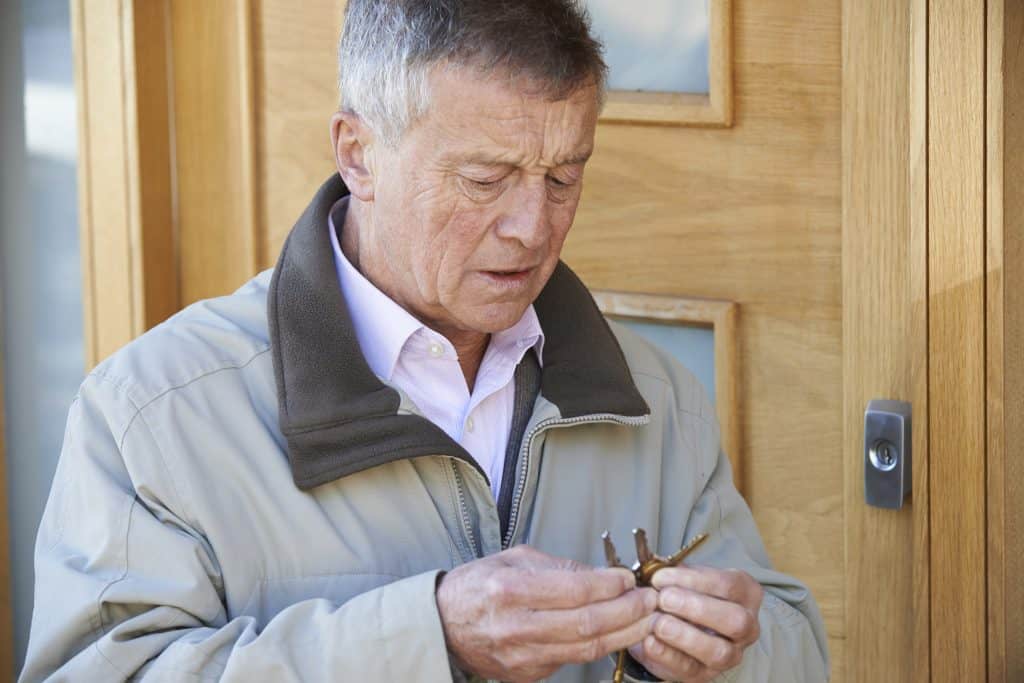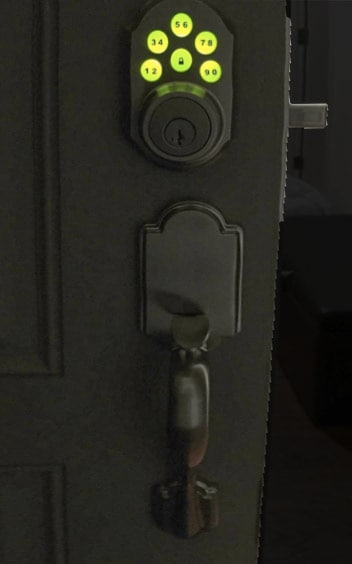

I hate carrying keys with me. I don’t know what it is, but I hate it. So when I moved into my first home, I decided to splurge on a Kwikset electronic deadbolt. The guy at the store promised me I’d love it, and he was right.
While the Kwikset 909 Smartcode is not a perfect device, and the install does take about 20 minutes, I found it to be a very worthwhile upgrade for any home, and in my opinion, this deadbolt is lightyears ahead of the competition.
How the Kwikset 909 Works
Basically, you install the deadbolt (more on that later). When it’s in, you enter in your passcode on the exterior of the door, and the motor drags in the bolt to open the door.
When you’re leaving the house, you press the center “lock” button on the exterior of the door and it puts the deadbolt in.
There is a normal keyhole if you want to use a normal key too, but as far as I’m concerned that’s totally useless. The beauty of the keycode is you never need to keep a key with you again!
I was worried at first that it would run out of batteries and I’d be stuck outside, but I was glad to see that the battery lasted about a year if I remember right. Also, it gives you a low battery warning long before it’s out so you’ll know to change it.
The lock is powered by 4 AA batteries that you can access by sliding up the panel on the inside of the lock.
Installing the Kwikset: Is it a pain in @#$%^&?
I’m not handy–at ALL. I’m embarrassing with a hammer. So installing the new deadbolt was a little daunting to me, but I was pleased to find directions that were actually written by an English speaker and I didn’t really need any special tools.
I installed two of these and they were both done in under 20 minutes.
The only thing I’d suggest is to make sure the hole is large enough in the door where the bolt goes in so that the bolt doesn’t get caught on the lip. The motor isn’t super strong, so you have to make sure it fits just right or it’ll get hung up.
The tools you’ll need are: a phillips screw driver, 4 AA batteries, and yourself. It’s really that easy. If your hole isn’t big enough in the door, just a little chisel and a hammer can be handy but not necessary.
The deadbolt is made to fit in both sizes of standard door holes.
Setting the Passcodes (And Using the Old-school Keys)
Again, the simplicity of this device shines in setting your codes. When you open up the panel on the inside of the door, it has easy step-by-step directions for you. Dummies like me need stuff like that 🙂
Anyway, there’s a button on the inside that you press and then you can enter a new code. You can program up to 30 codes on the Kwikset (wow!).
If you want to use an old-school key, you just put in the key, and then press the button. When you move out of your house or if you want to re-key the lock, there is no need to replace it. You simply go buy a new Kwikset key (with different keying) from Amazon and enter in the old key, press the button with the metal stick, and then put in the new key. Done! The lock is automagically rekeyed for you! It’s sooo cool!
This was really nice when we recently moved. We just gave the new owner a new set of keys and we were done.
Pricing
I compared the Kwikset against the Schlage electronic deadbolts and it’s not even CLOSE! The Kwikset is about $50 cheaper for an almost identical feature set. I also think the Kwikset looks a little nicer.
The biggest difference between the Kwikset 909 and most other electronic deadbolts is that the Kwikset actually has a motor that pushes open the deadbolt when the correct keycode is entered Most other deadbolts do the keycode and then you still have to turn the knob for the deadbolt, and this one is cheaper!
I got my Kwikset 909 on Amazon because it ships fast, it had more options for colors than in Home Depot, and I don’t have to pay sales tax 🙂
Check the current price of the Kwikset 909 on Amazon.
Why I Love Having My Digital Deadbolt
Aside from the inconvenience of carrying a key, and the extreme inconvenience of forgetting or losing a key and being locked out of the house, I like that my kids are always able to get in the home without me. It makes me feel more secure knowing they can always get inside and be safe.
I also love that I can have a password for the family that we don’t share with anyone, and we can set a guest password for houseguests or close friends if we ever need to let anyone in, and then we can simply change that guess password afterword so we know the home is secure.
After not having a key to my home for the last 3 years, when I recently moved, I found it extremely inconvenient to always dig into my pockets to get a key when holding groceries. I’ll be getting another Kwikset for this home in the next couple days.
Some of the Drawbacks to Having a Digital Deadbolt
The biggest drawback to a digital deadbolt really only applies if you aren’t very smart with how you set your code. The Kwikset allows you to choose any passcode. If you choose a repeating passcode like 131313 for example, only two of the buttons will get worn over time, so in theory a robber could guess. The solution? Don’t do that. Use more than two buttons for your passcode.
Another question is, what if someone spies on you with high power binoculars and sees your code? My response is that no lock is perfect. A traditional lock with a key is far less secure than a passcode because you can physically lose it, or someone could steal your purse and have your key in it and your ID saying where you live.
The only other drawback to a digital doorlock is that it runs on batteries and you have to replace them. I was concerned about this at first, but I found the battery to last almost an entire year, and when it runs out, it takes 2 minutes to replace the 4 AA batteries from the inside of the door.

